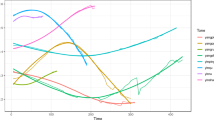Abstract
Auditory Gestalt perception by grouping of species-specific vocalizations to a perceptual stream with a defined meaning is typical for human speech perception but has not been studied in non-human mammals so far. Here we use synthesized models of vocalizations (series of wriggling calls) of mouse pups (Mus domesticus) and show that their mothers perceive the call series as a meaningful Gestalt for the release of instinctive maternal behavior, if the inter-call intervals have durations of 100–400 ms. Shorter or longer inter-call intervals significantly reduce the maternal responsiveness. We also show that series of natural wriggling calls have inter-call intervals mainly in the range of 100–400 ms. Thus, series of natural wriggling calls of pups match the time-domain auditory filters of their mothers in order to be optimally perceived and recognized. A similar time window exists for the production of human speech and the perception of series of sounds by humans. Neural mechanisms for setting the boundaries of the time window are discussed.



Similar content being viewed by others
Abbreviations
- dB:
-
Decibel
- SPL:
-
Sound pressure level
References
Akeroyd MA, Summerfield AQ (1999) A binaural analog of gap detection. J Acoust Soc Am 105:2807–2820
Anstis S, Saida S (1985) Adaptation to auditory streaming of frequency-modulated tones. J Exp Psychol: Hum Percep Perform 11:257–271
Bregman AS (1990) Auditory scene analysis. The MIT Press, Cambridge, MA
Brosch M, Schreiner CE (2000) Sequence sensitivity of neurons in cat primary auditory cortex. Cereb Cortex 10:1155–1167
Brosch M, Schulz A, Scheich H (1999) Processing of sound sequences in macaque auditory cortex: response enhancement. J Neurophysiol 82:1542–1559
Budd TW, Michie PT (1994) Facilitation of the N1 peak of the auditory ERP at short stimulus intervals. NeuroReport 5:2513–2516
Calford MB, Semple MN (1995) Monaural inhibition in cat auditory cortex. J Neurophysiol 73:1876–1891
Condon WS, Sander LW (1974) Neonate movement is synchronized with adult speech: interactional participation and language acquisition. Science 183:99–101
Culling JF, Summerfield Q (1998) Measurements of the binaural temporal window using a detection task. J Acoust Soc Am 103:3540–3553
Ehret G (1975) Schallsignale der Hausmaus (Mus musculus). Behaviour 52:38–56
Ehret G, Bernecker C (1986) Low-frequency sound communication by mouse pups (Mus musculus): wriggling calls release maternal behaviour. Anim Behav 34: 821–830
Ehret G, Riecke S (2002) Mice and humans perceive multiharmonic communication sounds in the same way. Proc Natl Acad Sci USA 99:479–482
Fay RR (1998) Auditory stream segregation in goldfish (Carassius auratus). Hear Res 120:69–76
Fay RR (2000) Spectral contrasts underlying auditory stream segregation in goldfish (Carassius auratus). JARO 01:120–128
Finlayson PG (1999) Post-stimulatory suppression, facilitation and tuning for delays shape responses of inferior colliculus neurons to sequential pure tones. Hear Res 131:177–194
Fishman YI, Reser DH, Arezzo JC, Steinschneider M (2001) Neural correlates of auditory stream segregation in primary auditory cortex of the awake monkey. Hear Res 151:167–187
Geissler DB, Ehret G (2002) Time-critical integration of formants for perception of communication calls in mice. Proc Natl Acad Sci USA 99:9021–9025
Hulse SH, MacDougall-Shackelton SA, Wisniewski B (1997) Auditory scene analysis by songbirds: stream segregation of bird song by European starlings (Sturnus vulgaris). J Comp Psychol 111:3–13
Kanwal JS, Medvedev AV, Micheyl C (2003) Neurodynamics for auditory stream segregation: tracking sounds in the mustached bat’s natural environment. Network 14:413–435
MacDougall-Shackelton SA, Hulse SH, Gentner TQ, White W (1998) Auditory scene analysis by European starlings (Sturnus vulgaris): perceptual segregation of tone sequences. J Acoust Soc Am 103:3581–3587
Ohala JJ (1975) The temporal regulation of speech. In: Fant G, Tatham MAA (eds) Auditory analysis and perception of speech. Academic Press, London, pp 431–453
Pinker S (1994) The language instinct: how the mind creates language. William Morrow, New York
Sachs L (1999) Angewandte Statistik. Springer, Berlin
Scharf B (1978) Loudness. In: Carterette EC, Friedman MP (eds) Handbook of perception vol IV hearing. Academic Press, New York, pp 187–242
Trehub SE (1985) Auditory pattern perception in infancy. In: Trehub SE, Schneider B (eds) Auditory development in infancy. Plenum Pres, New York, pp 183–195
Yabe H, Tervaniemi M, Reinikainen K, Näätänen R (1997) Temporal window of integration revealed by MMN to sound omission. NeuroReport 8:1971–1974
Yost WA (1991) Auditory image perception and analysis: the basis for hearing. Hear Res 56:8–18
Zwicker E, Feldtkeller R (1967) Das Ohr als Nachrichtenempfänger. Hirzel, Stuttgart
Zwislocki J, Hellman RP, Verrillo RT (1962) Threshold of audibility for short pulses. J Acoust Soc Am 34:1648–1652
Acknowledgements
This study was supported by the Deutsche Forschungsgemeinschaft (EH 53/17-3 and 19-1). The observations comply with the “Principles of animal care”, publication No. 86-23, revised 1985 of the National Institute of Health, and also with the current German laws.
Author information
Authors and Affiliations
Corresponding author
Rights and permissions
About this article
Cite this article
Gaub, S., Ehret, G. Grouping in auditory temporal perception and vocal production is mutually adapted: the case of wriggling calls of mice. J Comp Physiol A 191, 1131–1135 (2005). https://doi.org/10.1007/s00359-005-0036-y
Received:
Revised:
Accepted:
Published:
Issue Date:
DOI: https://doi.org/10.1007/s00359-005-0036-y




